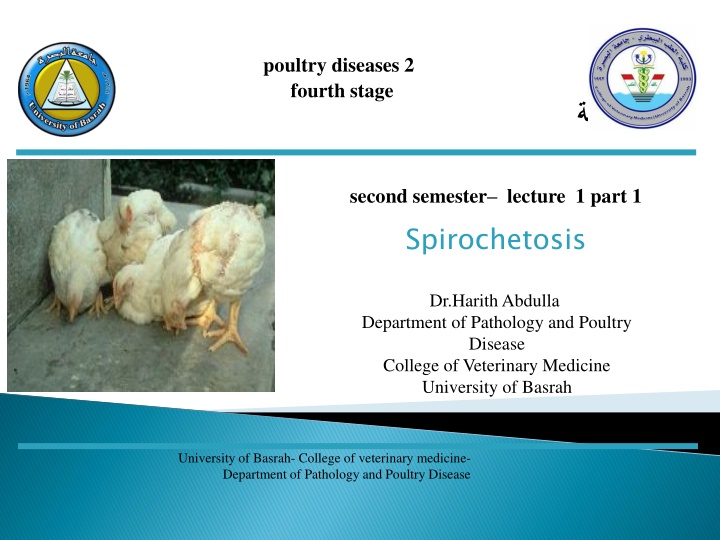
Spirochetosis in Poultry: Symptoms, Diagnosis, and Treatment
Spirochetosis is an acute bacterial disease affecting birds, caused by Borrelia anserina. It presents with symptoms like listlessness, depression, and anemia, and can be fatal if not treated promptly. Learn about the diagnosis, lesions, and treatment options for this disease to protect your poultry flock effectively.
Download Presentation

Please find below an Image/Link to download the presentation.
The content on the website is provided AS IS for your information and personal use only. It may not be sold, licensed, or shared on other websites without obtaining consent from the author. If you encounter any issues during the download, it is possible that the publisher has removed the file from their server.
You are allowed to download the files provided on this website for personal or commercial use, subject to the condition that they are used lawfully. All files are the property of their respective owners.
The content on the website is provided AS IS for your information and personal use only. It may not be sold, licensed, or shared on other websites without obtaining consent from the author.
E N D
Presentation Transcript
poultry diseases 2 fourth stage second semester lecture 1 part 1 Spirochetosis Dr.HarithAbdulla Department of Pathology and Poultry Disease College of Veterinary Medicine University of Basrah University of Basrah- College of veterinary medicine- Department of Pathology and Poultry Disease
Is an acute , febrile,septicemic bacterial disease affects a wide variety of birds. Etiology : The causal organism is Borrelia anserina , is an actively motile spirochete. Spirochetosis is found in temperate and or tropical regions, wherever the biologic vectors are found..The most common vector is Argas persicus. Etiology :
1-Listlessness. 2-Depression. 3-Somnolence. 4-Moderate to marked shivering. 5-Increased thirst. 6-Anemia is common. 7-Death occurs most often 1-3 days after Borrelia disapper from the blood stream.
Young birds are affected more severely than older ones.During the initial stages of the disease , there is usually a green or yellow diarrhea with increased urates.The course of the disease is 1-2 weeks .Morbidity can approaches 100% and mortality may be 33- 77%. Egg production in layers or breeders may be reduced by 5-10% with a higher number of small eggs.
1-An enlarged spleen with petechial or ecchymotic hemorrhages. 2- A grossly enlarged spleen with mottlling due to subcapsular hemorrhage is the predominant and characteristic lesions. 3- Focal necrotic hepatitis may also be present.
1-Demonstration of Borrelia in the blood. 2-Serological test. 3-Signs. 4-Lesions. Treatment: Several antibacterial agents are effective .The most widely used are pencillin derivatives, but the streptomycins, tetracyclines , and tylosin are also effective. Treatment:
1- A combination of tick eradication and immunization is the most effective means of control. 2-Vaccines.
